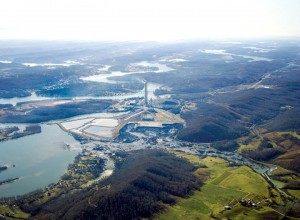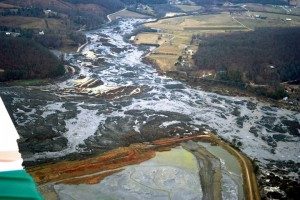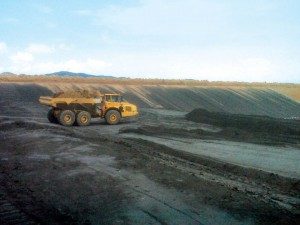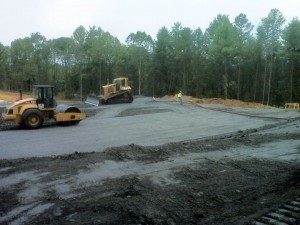EPA’s ruling on Coal Combustion Residuals.
By Boyd Ramsey
Introduction
On December 19, 2014, the United States Environmental Protections Agency (EPA) Administrator Gina McCarthy signed the Disposal of Coal Combustion Residuals (CCR) from Electric Utilities final rule. The rule will take full effect 180 days after the publication in the Federal Register.

The text for the rule is more than 450 pages and is filled with details and suggestions, requirements, regulations, and comments. It is impossible to provide sufficient details in this brief article to fully explain the rule, but an overview, specifically tailored to geosynthetics and their use in this application will be offered.
I urge those making decisions regarding the rule to review the text available on the EPA website.
The EPA has also published its own summary.
Also useful for reference is the EPA docket number: EPA-HQ-RCRA-2009-0640.
The rule
The EPA’s ruling establishes technical requirements for CCR landfills and surface impoundments under Subtitle D of the Resource Conservation and Recovery Act (RCRA), the nation’s primary law for regulating solid waste.
The final rule makes a number of changes from the initial EPA proposal including providing greater clarity on technical requirements in response to questions received during the comment period. Further, the rule sets out record-keeping and reporting requirements as well as the requirement for each facility to establish and post specific information to a publicly-accessible website. This final rule also supports the responsible recycling of CCRs by distinguishing safe, beneficial use from disposal.

The December 2008 disaster when a containment site in Kingston, Tenn., burst open and flooded 300 acres with coal-ash sludge. Photo: The Southern Alliance for Clean Energy, Executive Director Dr. Stephen A. Smith
Of primary impact is the EPA’s decision to apply the specification and technical guidance generally associated with RCRA Subtitle D to coal ash storage. In brief, Subtitle D requires a composite base liner consisting of a geomembrane and a clay (soil) or geosynthetic clay liner (GCL) component, a drainage system to manage liquid and head pressure control over this composite liner with a maximum head of 30cm (12in.) and a requirement that the barrier system used in capping and closure meet the Subtitle D requirements as well. EPA chose not to classify CCRs as hazardous waste and did not apply that regulation (RCRA Subtitle C) to CCRs.
The rule addresses CCR storage facilities by dividing them in to two basic types: “landfills” (LF) and “surface impoundments” (SI). The primary distinguishing factor is that a surface impoundment contains CCRs that are “wet,” meaning mixed with liquids and holding the potential for mobilization and movement if not properly contained. In contrast, CCR landfills, in general, contain materials that are relatively dry, have higher cohesion and lower mobility than wet CCR materials.
Actions and timing
Clearly the most recent coal ash contamination events (the Kingston, Tenn. disaster in 2008, the WE Energy spill into Lake Michigan in 2011, and the Duke Energy Dan River spill in 2014) all involved wet and mobilized coal ash.
The EPA has placed a primary focus on surface impoundments and has created a schedule to address these sites:
- sites not in compliance with structural stability assessment requirements are to be closed within 18 months.
- existing unlined sites with groundwater pollution issues are to be closed within 30 months.
- sites not in compliance with location restriction requirements are to be closed within 42 months.

Time extensions available for all the above:
- maximum extension for sites ≤ 40 acres is two years.
- maximum extension for sites ≥ 40 acres is 10 years; extensions are allowed in two-year increments.
“Closed” in this content means that structural stability has been validated and the site has been capped with a Subtitle D compliant cap system.
Further, the EPA has strongly motivated owners to close existing surface impoundments by allowing sites that do not have existing groundwater contamination issues and cease use and commence closure within six months to avoid being regulated by a large portion of the rules including, in most cases, groundwater monitoring and the associated reporting. This will, and already has, set off a flurry of SI closures.
In a related topic, also expected is an increase in the capping of existing surface impoundments that is augmented with stabilization geosynthetics and vertical geosynthetic-reinforced walls designed to allow sites to both cap existing surface impoundments and gain additional space for properly permitted and regulatory compliant disposal within the existing owner’s property boundaries.
Geosynthetics
Also of interest are the comments that EPA included related to the performance of geosynthetic composite liner systems and geosynthetic clay liners (GCLs) as a component of those systems. The EPA rulings signaled a strong preference for composite cover systems:
- “fewer problems are typically seen with the use of composite cover systems.”
- “ongoing oversight and proper maintenance is necessary to ensure the efficacy of any cover system, less effort is generally involved to ensure the continued performance of a composite cover system.”
- “EPA generally recommends that facilities install a composite cover system, rather than a compacted
clay barrier, as the composite system has often proven to be more
effective (and cost effective) over
the long term” - “EPA anticipates that composite cover systems will be recommended in many circumstances by qualified Professional Engineers.”

Further regarding GCLs:
“While EPA agrees with those commenters arguing that new CCR disposal units should only be installed with a composite liner system of some kind, the Agency has concluded that not all alternative designs for a composite liner system should necessarily be rejected as insufficiently protective … EPA’s own studies showing that a geomembrane (GM)/GCL liner can be constructed to achieve hydraulic efficiencies in the range of 99 to 99.9% which meets or exceeds the hydraulic performance of a GM/compacted clay liner (CCL) design.
“In addition, these high efficiencies demonstrate that the GCL component of a GM/GCL composite liner is at least as effective in impeding leakage through holes in the GM component of the composite liner system as a CCL with a hydraulic conductivity no more than 1 x 10-7cm/sec. In fact, EPA has developed guidance for the selection and installation of various types of liners including a GM/GCL … EPA has concluded, consistent with many of the comments received and its own analysis, that an alternative composite liner for new CCR units is warranted … As such, the Agency is allowing new CCR units to be designed and constructed with an alternative composite liner, as described below, provided the lower component of the composite liner meets a specified performance standard …”
Overall, this EPA rule is a strong endorsement of geosynthetic composite liners and will dramatically expand the market for these products as well as for other geosynthetic materials.
The role of GMA
It is important to note that this ruling is by no means a “happy accident.” In fact, the Geosynthetic Materials Association (GMA) has been working to achieve this for the past six years, attending public hearings, paying calls to federal agencies and members of Congress and providing data and information to support the positions that GMA espouses.
If you are one of the individuals or companies that contributed, you should feel very proud of this accomplishment. If you have not participated, you should use this as the opportunity to, through GMA, engage in your industry’s activities and become a positive force for the improvement of your industry, the global environment, and your country’s infrastructure.
Boyd Ramsey, chief engineer at GSE, is the immediate past chairman of the Geosynthetic Materials Association (GMA) Executive Council, and is a member of the board of directors for the Industrial Fabrics Association International (IFAI), the Geosynthetics Institute (GSI), and the International Geosynthetics Society (IGS).
 TEXTILES.ORG
TEXTILES.ORG


